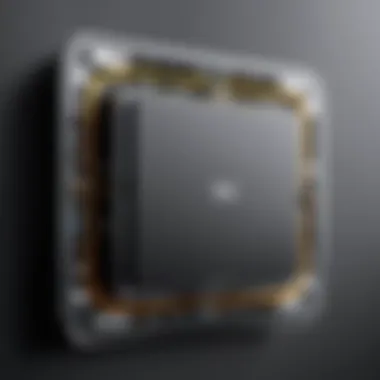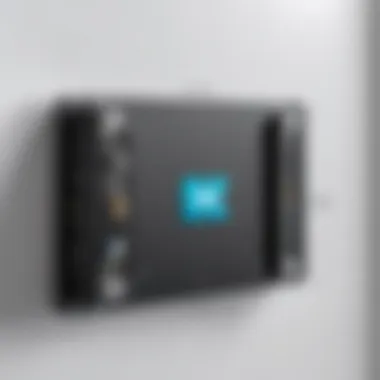Exploring TV Wall Mount Adapter Plates: A Comprehensive Guide


Intro
In today’s tech-savvy world, the demand for wall-mounted TVs has surged, making it crucial to understand the underlying components that allow for a secure installation. Among these components, TV wall mount adapter plates stand out as key players, acting as the crucial link between the television and the wall mount itself. These adapter plates not only ensure safety but also enhance the aesthetics of living spaces, allowing for seamless integration of technology into home environments.
The choice of an adapter plate often determines the stability and safety of the mounting setup. The process may seem simple at first glance, but the intricacies involved warrant a deeper exploration. From diverse designs tailored to various TV models, to the materials that impact durability, each element plays a significant role in ensuring that your TV remains safely affixed to the wall.
This narrative aims to illuminate the multifaceted nature of adapter plates, exploring their design philosophies, compatibility factors, and the essential considerations that any tech enthusiast or DIY builder should contemplate before making a selection. By dissecting this topic, readers are equipped to make informed decisions, ensuring their installations not only meet safety standards but also align with their technological aspirations.
Preface to TV Wall Mounts and Adapter Plates
When it comes to setting up a home entertainment system, one gets faced with several decisions, none quite so pivotal as the choice of where and how to mount the television. Enter TV wall mounts and adapter plates, unsung heroes behind the sleek, elevated screens many now take for granted. These tools not only maximize viewing pleasure but also bring a semblance of safety and stability to our beloved gadgets.
TV wall mounts come in various designs, each tailored to suit different needs and preferences. From fixed mounts that hold the screen in a steadfast position, to more sophisticated options allowing for tilting and full motion, wall mounts have evolved into essential components in the modern home. However, there’s a subtle yet crucial part of this mounting puzzle—the adapter plates.
The Role of Adapter Plates
Adapter plates serve as the connecting link between the wall mount and the television itself. They enable a seamless fit, ensuring that different TV models can securely attach to various mounting systems. Moreover, they are particularly useful when a user needs to swap one TV for another, where compatibility becomes key. With the rise of varying VESA standards and different TV dimensions, adapter plates mitigate the often frustrating complications that arise when installing a TV in a desired location.
By understanding the role of these plates, the user can avoid pitfalls. A mismatch between the adapter plate and the mounting system not only risks damaging the TV but also leads to unsightly installations. Choosing the appropriate adapter plate can provide confidence that the television is safely anchored.
Evolution of Wall Mount Systems
As technology advanced, so did the methods of installation for televisions. Initially, wall mounts were basic hooks meant to hold the TV slightly away from the wall, often leading to instability. However, innovation took over, and designs matured with a focus on stability and flexibility.
In the early 2000s, the introduction of standardized mounting systems, primarily the VESA (Video Electronics Standards Association) mounting pattern, changed the serialization of wall mounts entirely. This adaptability allowed for various types of adapter plates to be manufactured—each reflecting the evolutionary trajectory of design. Furthermore, the focus on aesthetics saw these structures become less intrusive, emphasizing slim profiles and minimized visibility.
Today’s market offers myriad options, blending functionality with modern decor trends. Therefore, understanding the evolution of these systems highlights not only the advancements in technology but also the growing awareness of the importance of these products in providing both safety and visual harmony to living spaces.
Types of TV Wall Mount Adapter Plates
When it comes to mounting a television, the choice of adapter plate can significantly affect both the functionality and aesthetics of your setup. Understanding the types of TV wall mount adapter plates is a key component in ensuring that your installation meets your needs, particularly in terms of viewing angles and spatial limitations.
Each type of adapter plate offers its own set of advantages and disadvantages, suited for different environments and user preferences. Let's delve deeper into the distinct categories.
Fixed Mount Adapter Plates
Fixed mount adapter plates are the simplest of all types. They keep the TV flush against the wall, providing a clean, minimalistic look. This design is particularly beneficial in spaces where there’s no need for angling the screen. They are robust and often support a wide range of weight capacities, making them suitable for most TV sizes.
The installation process for fixed mounts is straightforward, often requiring only basic tools.
Advantages:
- Space-efficient: Keeps TV close to the wall.
- Sturdiness: Supports heavy televisions with ease.
- Cost-effective: Generally more affordable than other types.
However, there are some drawbacks to consider. Once the TV is mounted, adjusting the angle or moving it is nearly impossible without unmounting.
Tilting Adapter Plates
If you want more flexibility without sacrificing wall proximity, tilting adapter plates are a great option. These plates allow you to tilt the TV downward, which can be particularly useful in high mounting situations, such as above a fireplace.
The tilt feature enables optimal viewing angles, reducing glare from windows and light fixtures. This makes tilting mounts popular among users who want to maintain both form and function.
Key Benefits:


- Enhanced Viewing Experience: Reduces glare and improves line of sight.
- Adaptability: Allows for some adjustments once mounted.
The downside, though, is that they typically come at a higher price point and may require a bit more precision during installation.
Full Motion Adapter Plates
Full motion adapter plates, as the name suggests, provide a wide range of motion. They allow vertical and horizontal adjustments, making it relatively easy to shift the TV left, right, up, or down as needed. This is perfect for rooms where furniture rearrangement might happen frequently, or for accommodating various viewing preferences.
Most full-motion mounts include extensive extension options that enable the TV to be pulled away from the wall before adjustments are made.
Considerations:
- Highly Adjustable: Ideal for multi-purpose rooms.
- Optimized Viewing: Facilitates various seating arrangements and eye levels.
However, complexity can increase during installation, and users must ensure they securely mount the system to avoid potential accidents.
Universal Adapter Plates
In a market that boasts a plethora of TV brands and models, universal adapter plates rose to prominence as a jack-of-all-trades solution. They are designed to fit multiple VESA patterns, making them compatible with a wide range of television sizes and types.
Pros of Universal Plates:
- Versatility: Works well across different TV models.
- Simple Replacement: A worthwhile choice if you plan on changing TVs often.
On the flip side, while universal adapters are great when you want to switch things up, they might not always offer the ideal support or tilt options for every TV model. Fitness for purpose becomes crucial.
In summary, understanding these various types of TV wall mount adapter plates — fixed, tilting, full motion, and universal — can guide a user to make the right choice tailored to their specific needs, preferences, and installation conditions.
Key Considerations When Choosing an Adapter Plate
Selecting the right TV wall mount adapter plate might seem like a straightforward task, but the implications of your choice can be significant. Choosing an appropriate adapter plate can ensure both the safety of your television and the aesthetics of your living space. It's not just about slapping your TV onto the wall; there’s a bit more thought that needs to go into it. Various factors come into play, such as the size of your TV and its weight, compatibility with mounting standards, the materials used for manufacturing, and even design considerations.
Whether you’re a tech enthusiast geared up for a gaming marathon, a DIY builder wanting to make the most of your space, or simply an electronic upgrader looking to create the perfect setup, understanding these elements can steer you toward making an informed choice.
TV Size and Weight Capacity
First up, let's talk size and weight. Each adapter plate comes with its own specifications regarding how much weight it can bear. It’s essential to check these numbers against the weight of your TV. Many people underestimate their television’s heft. If you have a large-screen model, like a 70-inch LED, it could weigh upward of 100 pounds!
To avoid any catastrophic failures, ensure your chosen adapter plate can safely accommodate your TV's weight. Ignoring this can lead to serious damage—both to your TV and your wall. If in doubt, a little extra capacity is always better; it’s like having a security blanket.
Mounting Compatibility Standards
VESA Standards
Now let’s dig into compatibility. VESA (Video Electronics Standards Association) standards are a big deal in the world of wall mounts. They define the dimensions of the mounting holes on the back of TVs, making sure that the adapter plate can align perfectly. This standardization makes finding a matching adapter a breeze.
A key characteristic of VESA standards is their versatility. You’ll often see mounting hole patterns ranging from 75x75mm to 800x400mm, accommodating various TVs.
- Why it’s popular: Because it simplifies compatibility.
- Unique Features: The patterns allow for flexible mounting options, which is great for different wall configurations.
However, specialized brands or older models may not adhere to these dimensions, so it’s wise to double-check your TV’s specifications.
Alternative Mounting Patterns
On the other hand, alternative mounting patterns might come into play, especially if you’re dealing with non-standard TVs. Some lesser-known brands or unique models may have non-VESA configurations. Understanding these options is essential if your model doesn’t align with standard VESA mount points.


This isn't as common but can be a headache if you’re not prepared.
- Key Characteristic: The uniqueness of each model usually makes it tricky to find the right fit.
- Why Consider Alternative Patterns: Sometimes unique aesthetics or specialized designs in TVs require custom solutions.
It’s always best to consult the television’s manual or manufacturer if unsure. These alternatives can sometimes lead you down a rabbit hole of custom adapters—so be cautious.
Material and Build Quality
When purchasing an adapter plate, the material and overall build quality are paramount. Cheaply made brackets might lure you in with their price, but failure to hold your television securely is a gamble you don’t want to take. Steel is often regarded as the gold standard, offering a robust option that stands the test of time. Look out for powder-coated finishes, which can help in preventing rust and fading.
Moreover, consider the design of the adapter plate itself. If it’s flimsy or poorly crafted, the risks increase. It’s worth investing in quality to keep your TV securely mounted.
Aesthetic Considerations
Finally, we can't forget about the aesthetic factor. How your TV integrates into your living space plays a significant role. Wall mounting shouldn’t just be functional, but it should also complement your home's decor. Depending on the design of the adapter plate, it can either blend seamlessly into your setup or stand out awkwardly.
There are minimalist mounts that are practically invisible, while others might add a bit of character to your space. Consider the finish and design, as something that matches the rest of your equipment can enhance your room’s overall appearance.
Choosing the right adapter plate encompasses more than just function; it’s about obtaining harmony in your space, too.
"Choosing an adapter plate is about finding balance—not just in functionality but in the design narrative of your living space."
In summary, opting for the right adapter plate means taking a holistic view of various components, ensuring that each one integrates into your setup gracefully and securely.
Installation Process of TV Wall Mount Adapter Plates
Understanding the installation process of TV wall mount adapter plates is crucial for anyone looking to enjoy a secure and stable display. This section shed light on the steps involved, guiding both novices and seasoned DIY enthusiasts through the ropes of mounting their televisions safely. A successful installation not only enhances the viewing experience but also ensures that the TV remains safeguarded against potential accidents that might arise from improper mounting. By taking the time to follow these detailed steps, one can be certain about creating an optimal setup.
Preparing the Wall and Tools
Before diving in, assembling the right tools and preparing the wall are foundational steps that often set the tone for a successful installation. Generally speaking, having a stud finder, level, drill, screwdriver, and measuring tape within arm's reach can save a great deal of time and heartache.
Firstly, identifying the wall structure is paramount. Is it drywall, plaster, or perhaps brick? The compatibility of these materials with your mounting system determines how securely the adapter plate can be attached. For example, brick walls may require masonry anchors, while drywall is usually best secured to wooden studs behind it.
Beyond knowing the wall type, it's also about mindset. "Measure twice, cut once" isn’t just for carpenters; it’s essential here as well. Take the time to double-check your wall and ensure everything is as it should be. A little patience upfront can spare you a heck of a lot of trouble down the line.
Marking the Mounting Points
With your wall prepped and tools ready to roll, the next step involves pinpointing the exact mounting points on the wall. This isn’t merely a matter of eyeballing it; accuracy is key. Begin by measuring the height at which you wish to place the TV, keeping in mind the viewer's line of sight and comfort.
Using your measuring tape, find the midpoint for mounting and mark this directly on the wall. Then, using the level, ensure that the markings indicate where the bracket aligns. It helps to highlight these spots with a pencil.
Remember, if the TV is heavy, aligning to the studs more than once can lend extra stability. A little tip? Testing the depth of the marked points with your drill can give additional confidence before making any permanent decisions.
Securing the Adapter Plate
Now comes the part where real progress is made: securing the adapter plate to the wall. This is where the rubber meets the road. Carefully align the adapter plate with the previously marked points and verify again that everything is level. Once it looks tidy, drill into the marked points while ensuring you don’t hit any electrical wires or plumbing hidden behind the wall.
Utilize the right screws; they must be substantial enough to carry the TV's weight. It often pays to weigh your options here—using lag bolts instead of standard screws can provide exceptional support. Ensure the plate is fastened tightly, as a loosely secured adapter can lead to disastrous results later on.
Tip: A good practice is to recheck the level before securing the final screws. A slight adjustment at this stage can prevent headaches later.
Mounting the TV
After securing the adapter plate firmly to the wall, the mounting of the TV itself is a comparatively easier task. It is crucial to enlist another person for assistance in this step, as managing the weight of the TV can be unwieldy.


Lift the TV and place it onto the mounted adapter plate, which can typically involve sliding brackets into grooves pre-installed for that purpose. During this process, it's essential to keep the final orientation in mind — which way does the viewer most want to see the screen?
Once the TV is placed, don’t forget to fasten any locking mechanisms that came with the adapter plate. These mechanisms are designed to add another layer of security, ensuring that everything stays put. With the TV in place and locked down, you can then step back and admire your handiwork, knowing that you’ve completed a critical step toward a perfect viewing setup.
Maintenance and Safety Guidelines
The maintenance and safety of your TV wall mount adapter plates are crucial. This aspect ensures not only the longevity of the mount itself but also the safety of your television. A sturdy, well-maintained mount protects your investment from potential hazards. Neglect here can lead to unforeseen accidents, damage, or even personal injury, particularly if the mount wasn’t installed correctly to begin with.
Regular upkeep can also improve performance. Dust, for instance, can weaken the mounting mechanism over time, while regular inspections can identify issues before they escalate. Understanding the guidelines for maintenance and safety is akin to tuning a fine instrument; neglecting the small things could lead to a significant dissonance.
Regular Inspection Practices
Routine inspections should become part of your home maintenance checklist, much like changing the oil in your car or cleaning out your gutters. A good starting point involves checking the integrity of the screws and bolts. Over time, fluctuations in temperature and humidity can affect metal parts, leading them to expand and contract. This movement may loosen connections, resulting in a precarious situation for your TV.
Additionally, inspect the wall where the adapter plate is mounted. Look for any cracks or signs of wear. If you spot an issue, it is better to act sooner rather than later.
A practical approach to inspections can be summarized with these steps:
- Visual Checks: Look for any visible signs of wear or fatigue.
- Tightening Loose Screws: Regularly check and tighten as needed.
- Documenting any Changes or Issues: Keeping a log can aid in noticing patterns over time.
"An ounce of prevention is worth a pound of cure."
Just a simple inspection can save you from future troubles.
Advice on Weight Adjustments
Weight adjustments are another key consideration. As TVs evolve and become lighter or heavier with new technology, the old mounts may not adequately support your new television. This can be particularly relevant for those who enjoy upgrading their technology regularly.
Before mounting a newer TV, check the weight rating of your adapter plate. Mismatches can lead to disastrous results, which are not only damaging to the TV but also dangerous.
Here are a couple of notes regarding weight adjustments:
- Know Your TV’s Weight: Refer to the manufacturer’s specifications to ascertain the weight.
- Adjustment Features: Some adapter plates come with features to adjust weight capacity, so aim for the right match.
- Consider Future Purchases: When choosing an adapter plate, think about the weight of potential future TVs you may consider.
Ensuring Proper Cable Management
Last but certainly not least, cable management is more than just an aesthetic choice—it’s vital for safety. If cables dangle carelessly, they could pose tripping hazards or damage delicate connectors. An organized setup prevents wear and tear, keeping everything safe and orderly.
Here are a few best practices to follow for effective cable management:
- Use Cable Clips: These can help secure cables along walls and behind the TV.
- Avoid Tight Bends: Be careful about creating sharp bends in cables, as this can wear on connectors over time.
- Regularly Assess Cabling Needs: As you add devices, consider how cables affect your setup and make adjustments accordingly.
By prioritizing maintenance and safety regarding cable management alongside periodic inspections and weight adjustments, you can ensure your TV wall mount adapter plates remain both functional and secure.
Ending and Future Trends in Wall Mount Technology
The topic of wall mount technology isn't just a fleeting fad; it's become a linchpin in home entertainment setups, dictating both aesthetics and functionality. The conclusion of this exploration highlights not only the necessity of adapter plates but also their evolving nature. In the grand scheme of device integration, a well-chosen adapter can make all the difference in ensuring safety and enhancing the user experience.
Technological Innovations
In the rapidly advancing field of home technology, innovation is the name of the game. New developments in wall mount systems are emerging at a faster pace than ever before. For example, some adapter plates now feature integrated cable management systems, which help keep those pesky cables neat and tidy. This isn't just about looks; it minimizes the hazard of tripping over loose cords and contributes to longevity by reducing wear and tear.
Additionally, smart technology integration is making its presence felt. Imagine a wall mount that not only holds your television but also syncs with your home assistant. This tech advancement could allow for automated adjustments to angles and positions based on viewing preferences or even automated updates for firmware compatibility as new models are released.
"The future of TV wall mount technology is full of potential, blending aesthetics and smart functionality to create user friendly environments."
Sustainability Considerations
As we transition further into an era marked by environmental awareness, sustainability is no longer just a buzzword - it's a necessity. Wall mount adapter plates must consider materials that are not only durable but also environmentally friendly. Manufacturers are being pressed to utilize recyclable materials and methods that decrease waste during production.
Another facet of sustainability includes the longevity and repairability of the products. Keeping up with the trends of minimalism and longevity, future designs should not only cater to quick fixes but also ensure that the materials can be repaired or replaced rather than discarded entirely.
Both consumers and manufacturers must shift their attention to acquiring products that reduce ecological footprints while providing efficient solutions. As tech enthusiasts become more discerning, the ability to choose. a sustainable, high-quality product can set a brand apart from the rest, making it crucial in today’s marketplace.



